Optimized at frequencies beyond traditional industry targets to support emerging applications
Different Types of Batteries and Their Applications
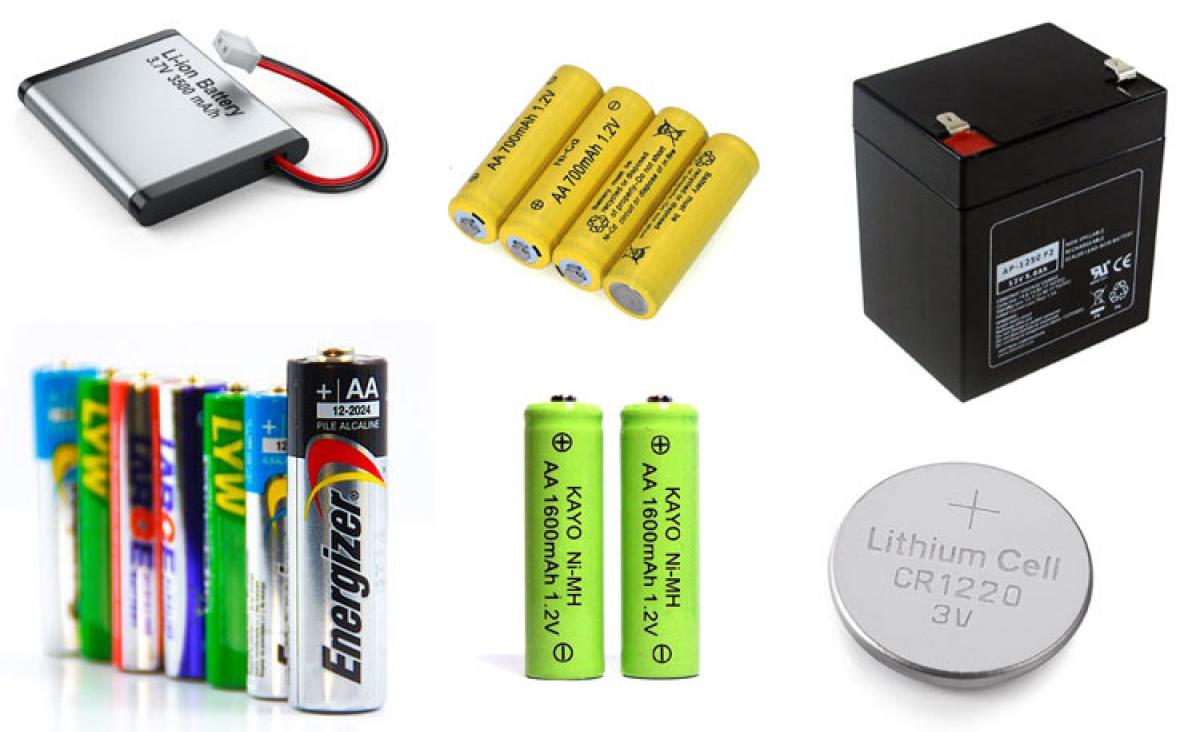
Battery is the primary power source for any electronics wireless gadget, be it a smartphone, laptop, watch or remote. Can you imagine the situation without these energy sources? We wouldn’t be able to build any wireless electronic device and have to rely on wired power source only, even electric cars and space missions would not be possible without Batteries. Today in this tutorial we discuss briefly about various types of batteries, their classification, terminology and specifications.
What is Battery and why it is used?
Let’s see the basic difference between a battery and a cell. Also let’s find out why we exactly need a battery and why can’t we use the Alternating power (i.e., AC power from the wall sockets) instead of DC power.
Cell: A cell is an energy source which can deliver only DC voltage and current which are in very small quantities. For example if we take cells that we use in watches or remote controls, it can give maximum of 1.5 – 3V.
Battery: The functionality of the battery is exactly same as that of a cell but a battery is a pack of cells arranged is a series/parallel fashion so that the voltage can be raised to desired levels. The best known example for a battery is a power bank which is used to charge up smart phones. If we ever see the inside of a power bank we can find set of batteries arranged serially/parallel based on the requirement. Batteries are arranged in series to increase the voltage and in parallel to increase the current.
Now Why DC is preferred over AC? In most of the portable electronics, AC can’t be stored where as DC can be stored without any difficulty. Even the losses due to AC power are more when compared to the DC power. That is the reason DC is preferred for portable electronic devices.
Technical terms used while dealing with batteries
We can’t just keep on using voltage and current alone to explain about a battery’s functionality, there are some unique terms that defines the characteristics of a battery like Watt-hour (mAh), C-rating, nominal voltage, charging voltage, charging current, discharging current, cut off voltage, shelf life, cycle life are the few terms used to define a batteries performance.
Let’s discuss each of the term briefly,
Power capacity:
It is the energy stored in a battery which is measured in Watt-hour
Watt-hour = V * I * hours {since voltage is kept constant, so it is measured in Ah/mAh}
We generally see the battery ratings as 2500 mAh or 4000 mAh while reading the specifications of a smart phone. What does that mean?? Let’s see
Example: 2500 mAh it means that the battery has a capability to deliver 2.5A/2500mA of current to the load for 1 hour. The time that the battery works continuously depends upon the load current that it consumes. So if the load consumes only 25 mA of current then the battery can stay alive for 100 hours. How is it?
25 mA * 100 hours {so 25 mA of current for 100 hours}
Similarly 250 mA for 10 hours So on…
Though the theoretical calculations seem ideal but the battery’s duration changes based on the temperature and the current consumption etc.
Power capability:
It means the amount of current that the battery can deliver. It is also known as C-rating.
Theoretically, it is calculated as A-h divided by 1 hour.
Example: Let’s consider a battery which has 10000 mAh of power capacity.
After dividing 10000 mA hour/1 hour gives 10000 mA = 10 A = 10 C
So, a battery with 10000 mAh of capacity will have a C rating of 10 C which means the battery has a capability of delivering 10 A of current at a constant voltage (fixed voltage/rated voltage).
If a battery has 1C rating then the battery has a capability of delivering 1A of current.
Note: Higher the C rating, more the current that can be drawn from the battery.
Nominal voltage:
While defining power capacity we have a unit called Wh which can be elaborated as V * I * hour but where did the voltage gone? As the voltage of the battery will be constant and will not be varied, it is considered as nominal voltage (fixed voltage). So since the voltage is fixed only Ampere and hour are considered as the unit (Ah/mAh).
Charging current:
It is the maximum current that can be applied to charge the battery i.e., practically maximum of 1A/2A can be applied if a battery protecting circuit is in-built but still 500 mA is the best the range for charging the battery.
Charging voltage:
It is the maximum voltage that should be applied to the battery to efficiently charge a battery. Basically 4.2 V is the best/standard charging voltage. Though we apply 5 V to the battery it accepts only 4.2 V.
Discharging current:
It is the current that can be drawn from the battery and is delivered to the load. If the current drawn by the load is greater than the rated discharging current, the battery drains very fast which causes the battery heat up quickly which also causes the battery to explode. So it is cautious to determine the amount of current drawn by the load as well as the maximum discharging current a battery can withhold.
Shelf life:
There might be a situation where the batteries are kept idle/sealed especially in the stores/shops for a long period of time. So shelf life defines the time period a battery can be stay powered up and should be able to use it for a rated time period. Shelf life is mainly considered for non-rechargeable batteries because those are of use and throw. For rechargeable batteries even if the shelf time is less, we can still recharge it.
Cut-off voltage:
It is the voltage at which the battery can be considered as fully discharged, after which if we still try to discharge from it the battery gets damaged. So beyond the cut-off voltage the battery should be disconnected from the circuit and should be charged appropriately.
Cycle life:
Let’s consider a battery is fully charged and it is discharged to 80% of its actual capacity, then the battery is said to be completed one cycle. Likewise the number of such cycles that a battery can charge and discharge defines the cycle life. The more the cycle life the better will be the battery’s quality. But if a battery is discharged to say 40% of its actual capacity considering the battery is fully charged initially, it cannot be considered as a cycle life.
Power density:
It defines power capacity of battery for a given mass of volume.
For example 100 Wh/Kg (Alkaline battery standard power density) implies that for 1 Kg of chemical composition it provides 100 Wh of power capacity.
Now, volume of a AAA alkaline battery is 11.5 grams. So if 1Kg can give 100 Wh capacity, then how much a 11.5 gram AAA batery can give?? Let’s calculate.
Wh (for 11.5 gm) = 100*11.5/1000 = 1.15 Wh
So, we know the nominal voltage of alkaline battery is 1.5V. So it provides 1.5V * (1.15/1.5)A * 1 hour gives 0.76 Ah = 760 mAh of power capacity which is almost equal to the power capacity of a standard AAA alkaline battery.
Different Types of Batteries
Batteries are basically classified into 2 types:
- Non-rechargeable batteries (primary batteries)
- Rechargeable batteries (secondary batteries)
Non-rechargeable Batteries
These types of batteries are basically considered as primary batteries because they can be used only once. These batteries cannot be recharged and used again. Let’s see about the regular, daily life primary batteries that we see.
- Alkaline batteries: It is basically constructed with the chemical composition of Zinc (Zn) and Manganese dioxide (MnO2), as the electrolyte used in it is potassium hydroxide which is purely an alkaline substance the battery is named as alkaline battery having he power density of 100 Wh/Kg.
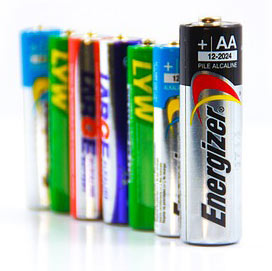
Advantages:
- Cycle life is more
- More compatible and efficient for powering up portable devices.
- Shelf life is more.
- Small in size.
- Highly efficient.
- Low internal resistance so that discharge state in idle state is less.
- Leakage is low.
Disadvantages:
- Cost is a bit high. Except it everything is an advantage.
Applications:
It can used in torches, remotes, wall clocks, small portable gadgets etc.
- Coin cell batteries: The chemical composition of coil cell batteries is also alkaline in nature. Apart from alkaline composition, lithium and silver oxide chemicals will be used to manufacture these batteries which are more efficient in providing steady and stable voltage in such a small sizes. It has Power density of 270 Wh/Kg.
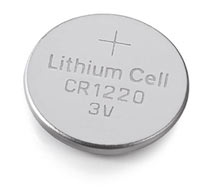
Advantages:
- Light in weight
- Small in size
- High density
- Low cost
- High nominal voltage (up to 3V)
- Easy to get high voltages by arranging serially
- Long shelf life
Disadvantages:
- Needs a holder
- Low current draw capability
Applications:
These types of batteries are used in watches, wall clocks, weighing machines, and other low power miniature electronic products etc.
Rechargeable Batteries
These types of batteries are generally called as secondary batteries which can be recharged and can be reused. Though the cost is high, but they can be recharged and reused and can have a huge life span when properly used and safely charged.
Lead-acid batteries
It consists of lead-acid which is very cheap and seen mostly in cars and vehicles to power the lighting systems in it. These are more preferable in the products where the size/space and weight doesn’t matter. These comes with the nominal voltage starting 2V to24V and most commonly seen as 2V, 6V, 12V and 24V batteries. It has Power density of 7 Wh/Kg.
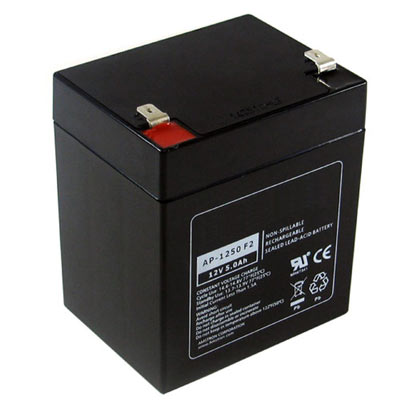
Advantages:
- Cheap in cost
- Easily rechargeable
- High power output capability
Disadvantages:
- Very heavy
- Occupies much space
- Power density is very low
Applications:
Used in cars, UPS (uninterrupted Power Supply), robotics, heavy machinery etc..
Ni-Cd batteries
These batteries are made of Nickel and Cadmium chemical composition. Though these are very rarely used, these are very cheap and their discharge rate is very low when compared to NiMH batteries. These are available in all standard sizes like AA, AAA, C and rectangular shapes. The nominal voltage is 1.2V, often connected together in a set of 3 which gives 3.6V. It has Power density of 60 Wh/Kg.
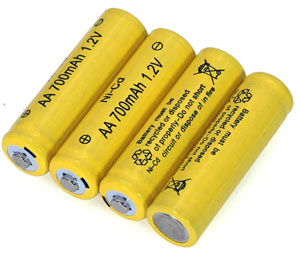
Advantages:
- Cheap in cost
- Easy to recharge
- Can be used in all environments
- Comes in all standard sizes
Disadvantages:
- Lower power density
- Contains toxic metal
- Needs to be charged very frequently in order to avoid growth of crystals on the battery plate.
Applications:
Used in RC toys, cordless phones, solar lights and mostly in the applications where price is important.
Ni-MH batteries
The Nickel – Metal Hydride batteries are much preferable than Ni-Cad batteries because of their lower environmental impact. Its nominal voltage is 1.25 V which is greater than Ni-Cad batteries. It has less nominal voltage than alkaline batteries and they are good replacement due to its availability and less environmental impact. The power density of Ni-MH batteries is 100 Wh/Kg.
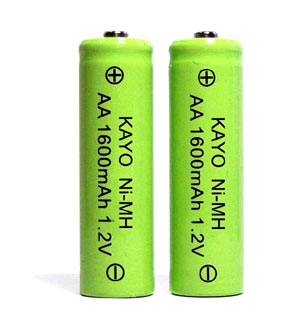
Advantages:
- Available in all standard sizes.
- High power density.
- Easy to recharge.
- A good alternative to alkaline which has almost all similarities and also it is rechargeable.
Disadvantages:
- Self-discharge is very high.
- Expensive than Ni-Cad batteries.
Applications:
Used in all applications similar to the alkaline and Ni-Cad batteries.
Li-ion batteries
These are made up of Lithium metal and are latest in rechargeable technology. As these are compact in size they can be used in most of the portable applications which need high power specifications. These are the best rechargeable batteries available. These have a nominal voltage of 3.7V (most commonly we have 3.6V and 7.2V) and have various ranges of power capacity (starting from 100s of mAh to 1000s of mAh). Even the C-rating ranges from 1C to 10C and Power density of Li-ion batteries is 126 Wh/Kg.

Advantages:
- Very light in weight.
- High C-rating.
- Power density is very high.
- Cell voltage is high.
Disadvantages:
- These are a bit expensive.
- If the terminals are short circuited the battery might explode.
- Battery protection circuit is needed.
Li-Po batteries
These are also called as Lithium Ion polymer rechargeable batteries because it uses high conductivity polymer gel/polymers electrolyte instead of liquid electrolyte. These come under the Li-ion technology. These are a bit costly. But the battery is very highly protected when compared to the Li-ion batteries. It has Power density of 185 Wh/Kg.
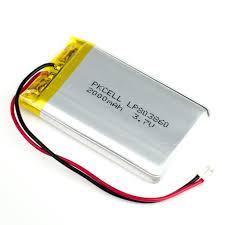
Advantages:
- These are highly protective compared to Li-ion batteries.
- Very light in weight
- Thin in structure when compared to Li-ion batteries.
- Power density, nominal voltages are comparatively very high compared to Ni-Cad and Ni-MH batteries.
Disadvantages:
- Expensive.
- Might explode if wrongly connected.
- Should not be bent or exposed to high temperature which may cause to explosion.
Applications: Can be used in all the portable devices which need rechargeable advantage like drones, robotics, RC toys etc.








